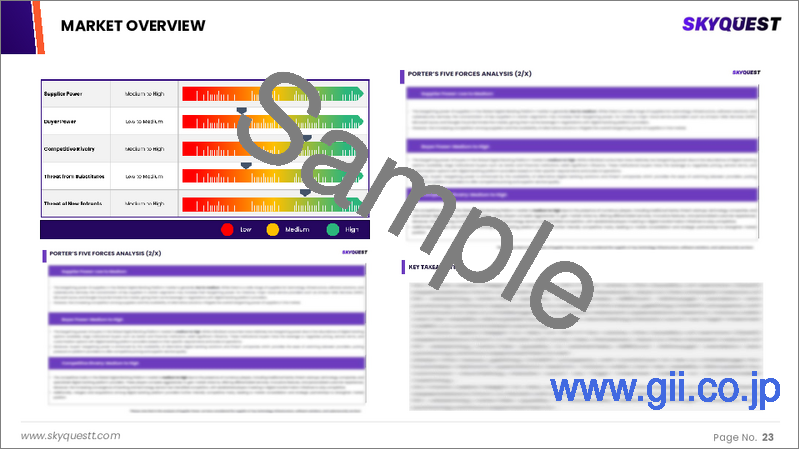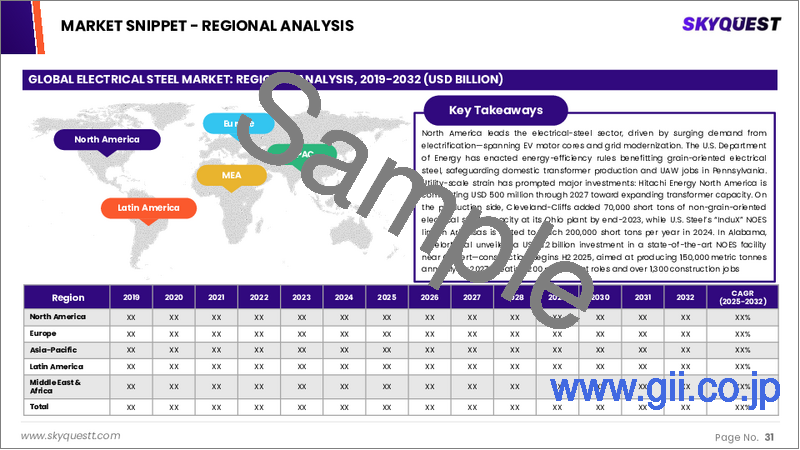|
|
市場調査レポート
商品コード
1673550
電磁鋼板の市場規模、シェア、成長分析、製品別、製造プロセス別、シリコン含有量別、コーティング別、用途別、エンドユーザー産業別、地域別 - 産業予測 2025~2032年Electrical Steel Market Size, Share, and Growth Analysis, By Product, By Manufacturing Process, By Silicon Content, By Coating, By Application, By End-User Industry, By Region - Industry Forecast 2025-2032 |
||||||
|
|||||||
| 電磁鋼板の市場規模、シェア、成長分析、製品別、製造プロセス別、シリコン含有量別、コーティング別、用途別、エンドユーザー産業別、地域別 - 産業予測 2025~2032年 |
|
出版日: 2025年03月02日
発行: SkyQuest
ページ情報: 英文 184 Pages
納期: 3~5営業日
|
全表示
- 概要
- 目次
電磁鋼板の世界市場規模は、2023年に372億7,000万米ドルと評価され、2024年の395億4,000万米ドルから2032年には635億米ドルに成長し、予測期間(2025-2032年)のCAGRは6.1%で成長する見通しです。
電磁鋼板市場は、配電部門に不可欠なモーター、発電機、リレーなど、さまざまな電磁機器に不可欠な役割を果たすことで、大きな成長が見込まれています。世界第2位の発電国である米国では、2023年に再生可能エネルギー発電量が16.7%増加すると報告されており、電磁鋼板の需要がさらに高まっています。さらに、電気自動車(EV)産業は、この特殊鋼がモーター効率の改善、自動車航続距離の延長、環境基準の向上に不可欠であるため、主要な成長触媒として機能しています。2023年に409億米ドルと評価された同市場は、2032年までに687億米ドルに達すると予測され、2025年から2032年までのCAGRは6.7%と顕著で、堅調な拡大を示しています。
目次
イントロダクション
- 調査の目的
- 調査範囲
- 定義
調査手法
- 情報調達
- 二次と一次データの方法
- 市場規模予測
- 市場の前提条件と制限
エグゼクティブサマリー
- 世界市場の見通し
- 供給と需要の動向分析
- セグメント別機会分析
市場力学と見通し
- 市場概要
- 市場規模
- 市場力学
- 促進要因と機会
- 抑制要因と課題
- ポーターの分析
主な市場の考察
- 重要成功要因
- 競合の程度
- 主な投資機会
- 市場エコシステム
- 市場の魅力指数(2024年)
- PESTEL分析
- マクロ経済指標
- バリューチェーン分析
- 価格分析
- ケーススタディ
- 規制情勢
電磁鋼板の市場規模:製品別& CAGR(2025-2032)
- 市場概要
- 木目重視の電磁鋼板
- 非木目指向電磁鋼板
電磁鋼板の市場規模:製造プロセス別& CAGR(2025-2032)
- 市場概要
- 冷間圧延
- 熱間圧延
- 連続焼鈍
- バッチアニール
電磁鋼板の市場規模:シリコン含有量別& CAGR(2025-2032)
- 市場概要
- -1.5%
- -2.5%
- -3.5%
- -4.5%
電磁鋼板の市場規模:コーティング別& CAGR(2025-2032)
- 市場概要
- オイル加工
- 無機
- オーガニック
- ハイブリッド
電磁鋼板の市場規模:用途別& CAGR(2025-2032)
- 市場概要
- トランスフォーマー
- モーター
- インダクタ
電磁鋼板の市場規模:エンドユーザー産業別& CAGR(2025-2032)
- 市場概要
- 自動車
- エネルギー
- 製造業
- 家電製品
電磁鋼板の市場規模& CAGR(2025-2032)
- 北米
- 米国
- カナダ
- 欧州
- ドイツ
- スペイン
- フランス
- 英国
- イタリア
- その他欧州地域
- アジア太平洋地域
- 中国
- インド
- 日本
- 韓国
- その他アジア太平洋地域
- ラテンアメリカ
- ブラジル
- その他ラテンアメリカ地域
- 中東・アフリカ
- GCC諸国
- 南アフリカ
- その他中東・アフリカ
競合情報
- 上位5社の比較
- 主要企業の市場ポジショニング(2024年)
- 主な市場企業が採用した戦略
- 最近の市場動向
- 企業の市場シェア分析(2024年)
- 主要企業の企業プロファイル
- 企業の詳細
- 製品ポートフォリオ分析
- 企業のセグメント別シェア分析
- 収益の前年比比較(2022-2024)
主要企業プロファイル
- ArcelorMittal(Luxembourg)
- POSCO(South Korea)
- Voestalpine AG(Austria)
- China Baowu Steel Group Corporation(China)
- Nippon Steel Corporation(Japan)
- United States Steel Corporation(USA)
- Steel Authority of India Limited(India)
- TATA Steel Limited(India)
- Thyssenkrupp AG(Germany)
- JFE Steel Corporation(Japan)
- Shagang Group Inc.(China)
- Ansteel Group Corporation(China)
- Shandong Iron and Steel Group Co Ltd(China)
- NLMK Group(Russia)
- AK Steel Holding Corporation(USA)
- Baosteel Group(China)
- SSAB AB(Sweden)
- Hyundai Steel Company(South Korea)
- Voestalpine Stahl GmbH(Austria)
- Outokumpu Oyj(Finland)
結論と提言
Global Electrical Steel Market size was valued at USD 37.27 billion in 2023 and is poised to grow from USD 39.54 billion in 2024 to USD 63.5 billion by 2032, growing at a CAGR of 6.1% during the forecast period (2025-2032).
The electrical steel market is poised for significant growth, driven by its essential role in a variety of electromagnetic devices such as motors, generators, and relays, which are vital for the power distribution sector. As the second-largest electricity generator globally, the U.S. reported a 16.7% increase in renewable energy generation in 2023, further enhancing the demand for electrical steel. Additionally, the electric vehicle (EV) industry serves as a key growth catalyst, as this specialized steel is critical for improving motor efficiency, extending vehicle range, and meeting rising environmental standards. The market, valued at USD 40.9 billion in 2023, is projected to reach USD 68.7 billion by 2032, with a notable CAGR of 6.7% from 2025 to 2032, signaling robust expansion.
Top-down and bottom-up approaches were used to estimate and validate the size of the Global Electrical Steel market and to estimate the size of various other dependent submarkets. The research methodology used to estimate the market size includes the following details: The key players in the market were identified through secondary research, and their market shares in the respective regions were determined through primary and secondary research. This entire procedure includes the study of the annual and financial reports of the top market players and extensive interviews for key insights from industry leaders such as CEOs, VPs, directors, and marketing executives. All percentage shares split, and breakdowns were determined using secondary sources and verified through Primary sources. All possible parameters that affect the markets covered in this research study have been accounted for, viewed in extensive detail, verified through primary research, and analyzed to get the final quantitative and qualitative data.
Global Electrical Steel Market Segments Analysis
Global Electrical Steel Market is segmented by Product, Manufacturing Process, Silicon Content, Coating, Application, End-User Industry and region. Based on Product, the market is segmented into Grain Oriented Electrical Steel and Non-Grain Oriented Electrical Steel. Based on Manufacturing Process, the market is segmented into Cold Rolled, Hot Rolled, Continuous Annealed and Batch Annealed. Based on Silicon Content, the market is segmented into 0.5-1.5%, 1.5-2.5%, 2.5-3.5% and 3.5-4.5%. Based on Coating, the market is segmented into Oiled, Inorganic, Organic and Hybrid. Based on Application, the market is segmented into Transformers, Motors and Inductors. Based on End-User Industry, the market is segmented into Automotive, Energy, Manufacturing and Household Appliances. Based on region, the market is segmented into North America, Europe, Asia Pacific, Latin America and Middle East & Africa.
Driver of the Global Electrical Steel Market
A significant factor propelling the growth of the Global Electrical Steel market is the increasing demand for electric motors within residential, commercial, and industrial sectors. Electrical steel plays a crucial role in manufacturing motors that deliver enhanced magnetic flux and torque, along with power generators boasting superior electromagnetic characteristics and reduced carbon dioxide emissions. Furthermore, the rising popularity of hybrid and electric vehicles (H/EVs) is contributing to this market's expansion. Components made from electrical steel in vehicles not only weigh less but also improve their overall aesthetics and safety features, further driving the demand for this essential material.
Restraints in the Global Electrical Steel Market
One of the primary constraints facing the Global Electrical Steel market is the substantial initial investment needed for its development and production. Establishing manufacturing facilities and acquiring cutting-edge technologies pose significant financial hurdles, especially for newcomers to the market. Building an electrical steel plant entails considerable expenditures on infrastructure, specialized equipment, and machinery. Additionally, the financial implications of research and development, process optimization, and adherence to regulatory standards further compound the investment challenges. This high upfront cost can discourage potential entrants and hinder the growth of current players, as the lengthy payback periods and uncertain returns make it difficult to rationalize such capital investments, thereby restricting overall market expansion.
Market Trends of the Global Electrical Steel Market
The Global Electrical Steel market is experiencing significant growth, propelled by the increasing demand for electricity driven by rapid population growth, urbanization, and industrial expansion. As the world shifts towards more energy-efficient practices, electrical steel is pivotal due to its superior magnetic properties, essential in manufacturing transformers and generators. This material enhances energy efficiency and minimizes losses in power transmission and distribution, addressing the critical need for reliable electricity supply. With these dynamics, the market is poised for robust expansion, integrating advancements in technology and sustainability while meeting the escalating global demand for electrical infrastructure and energy efficiency solutions.
Table of Contents
Introduction
- Objectives of the Study
- Scope of the Report
- Definitions
Research Methodology
- Information Procurement
- Secondary & Primary Data Methods
- Market Size Estimation
- Market Assumptions & Limitations
Executive Summary
- Global Market Outlook
- Supply & Demand Trend Analysis
- Segmental Opportunity Analysis
Market Dynamics & Outlook
- Market Overview
- Market Size
- Market Dynamics
- Drivers & Opportunities
- Restraints & Challenges
- Porters Analysis
- Competitive rivalry
- Threat of substitute
- Bargaining power of buyers
- Threat of new entrants
- Bargaining power of suppliers
Key Market Insights
- Key Success Factors
- Degree of Competition
- Top Investment Pockets
- Market Ecosystem
- Market Attractiveness Index, 2024
- PESTEL Analysis
- Macro-Economic Indicators
- Value Chain Analysis
- Pricing Analysis
- Case Studies
- Regulatory Landscape
Global Electrical Steel Market Size by Product & CAGR (2025-2032)
- Market Overview
- Grain Oriented Electrical Steel
- Non-Grain Oriented Electrical Steel
Global Electrical Steel Market Size by Manufacturing Process & CAGR (2025-2032)
- Market Overview
- Cold Rolled
- Hot Rolled
- Continuous Annealed
- Batch Annealed
Global Electrical Steel Market Size by Silicon Content & CAGR (2025-2032)
- Market Overview
- 0.5-1.5%
- 1.5-2.5%
- 2.5-3.5%
- 3.5-4.5%
Global Electrical Steel Market Size by Coating & CAGR (2025-2032)
- Market Overview
- Oiled
- Inorganic
- Organic
- Hybrid
Global Electrical Steel Market Size by Application & CAGR (2025-2032)
- Market Overview
- Transformers
- Motors
- Inductors
Global Electrical Steel Market Size by End-User Industry & CAGR (2025-2032)
- Market Overview
- Automotive
- Energy
- Manufacturing
- Household Appliances
Global Electrical Steel Market Size & CAGR (2025-2032)
- North America (Product, Manufacturing Process, Silicon Content, Coating, Application, End-User Industry)
- US
- Canada
- Europe (Product, Manufacturing Process, Silicon Content, Coating, Application, End-User Industry)
- Germany
- Spain
- France
- UK
- Italy
- Rest of Europe
- Asia Pacific (Product, Manufacturing Process, Silicon Content, Coating, Application, End-User Industry)
- China
- India
- Japan
- South Korea
- Rest of Asia-Pacific
- Latin America (Product, Manufacturing Process, Silicon Content, Coating, Application, End-User Industry)
- Brazil
- Rest of Latin America
- Middle East & Africa (Product, Manufacturing Process, Silicon Content, Coating, Application, End-User Industry)
- GCC Countries
- South Africa
- Rest of Middle East & Africa
Competitive Intelligence
- Top 5 Player Comparison
- Market Positioning of Key Players, 2024
- Strategies Adopted by Key Market Players
- Recent Developments in the Market
- Company Market Share Analysis, 2024
- Company Profiles of All Key Players
- Company Details
- Product Portfolio Analysis
- Company's Segmental Share Analysis
- Revenue Y-O-Y Comparison (2022-2024)
Key Company Profiles
- ArcelorMittal (Luxembourg)
- Company Overview
- Business Segment Overview
- Financial Updates
- Key Developments
- POSCO (South Korea)
- Company Overview
- Business Segment Overview
- Financial Updates
- Key Developments
- Voestalpine AG (Austria)
- Company Overview
- Business Segment Overview
- Financial Updates
- Key Developments
- China Baowu Steel Group Corporation (China)
- Company Overview
- Business Segment Overview
- Financial Updates
- Key Developments
- Nippon Steel Corporation (Japan)
- Company Overview
- Business Segment Overview
- Financial Updates
- Key Developments
- United States Steel Corporation (USA)
- Company Overview
- Business Segment Overview
- Financial Updates
- Key Developments
- Steel Authority of India Limited (India)
- Company Overview
- Business Segment Overview
- Financial Updates
- Key Developments
- TATA Steel Limited (India)
- Company Overview
- Business Segment Overview
- Financial Updates
- Key Developments
- Thyssenkrupp AG (Germany)
- Company Overview
- Business Segment Overview
- Financial Updates
- Key Developments
- JFE Steel Corporation (Japan)
- Company Overview
- Business Segment Overview
- Financial Updates
- Key Developments
- Shagang Group Inc. (China)
- Company Overview
- Business Segment Overview
- Financial Updates
- Key Developments
- Ansteel Group Corporation (China)
- Company Overview
- Business Segment Overview
- Financial Updates
- Key Developments
- Shandong Iron and Steel Group Co Ltd (China)
- Company Overview
- Business Segment Overview
- Financial Updates
- Key Developments
- NLMK Group (Russia)
- Company Overview
- Business Segment Overview
- Financial Updates
- Key Developments
- AK Steel Holding Corporation (USA)
- Company Overview
- Business Segment Overview
- Financial Updates
- Key Developments
- Baosteel Group (China)
- Company Overview
- Business Segment Overview
- Financial Updates
- Key Developments
- SSAB AB (Sweden)
- Company Overview
- Business Segment Overview
- Financial Updates
- Key Developments
- Hyundai Steel Company (South Korea)
- Company Overview
- Business Segment Overview
- Financial Updates
- Key Developments
- Voestalpine Stahl GmbH (Austria)
- Company Overview
- Business Segment Overview
- Financial Updates
- Key Developments
- Outokumpu Oyj (Finland)
- Company Overview
- Business Segment Overview
- Financial Updates
- Key Developments





